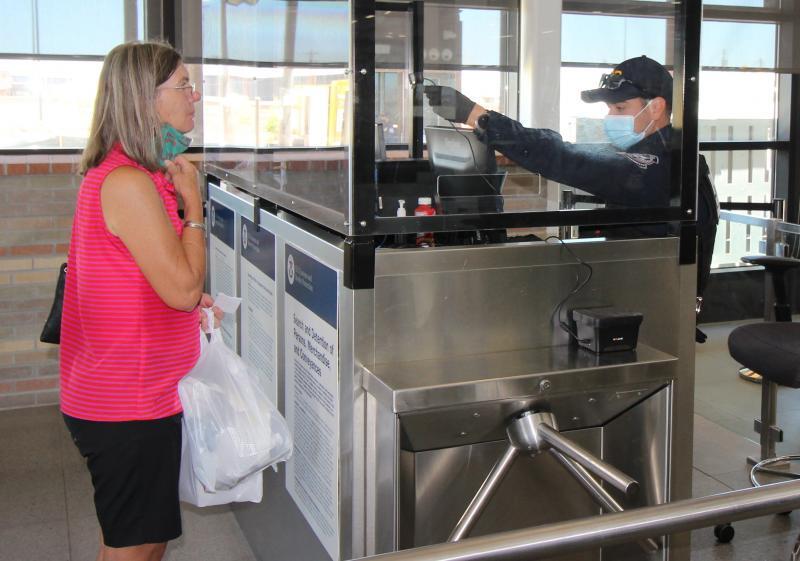EL PASO, TEXAS — U.S. Customs and Border Protection (CBP) is introducing Simplified Arrival at multiple pedestrian border crossings within the El Paso Field Office area of operations.
Simplified Arrival is an enhanced international arrival process that uses biometric facial comparison technology to automate the manual document checks that are already required for admission into the United States. This process provides travelers with a secure, touchless travel experience while fulfilling a longstanding Congressional mandate to biometrically record the entry and exit of non-U.S. citizens.
“The use of facial biometrics will further secure and streamline travel and supports our ongoing travel recovery efforts. This system facilitates lawful travel while maintaining the highest security and privacy standards,” said Hector Mancha, CBP Director of Field Operations for the El Paso Field Office. “The touchless identity verification process will enhance and expedite the travel experience for the millions of people who enter the United States through ports in our region every year.”
In New Mexico, CBP Officers working at the Santa Teresa and Columbus ports began using Simplified Arrival earlier this month.
CBP officers working at the Santa Teresa port processed approximately 77,000 pedestrians and 426,000 arriving vehicles in fiscal year 2020. During fiscal year 2019 and before pandemic travel restrictions CBP officers working at Santa Teresa processed approximately 172,000 pedestrians and 574,000 arriving vehicles.
CBP officers working at the Columbus port processed approximately 205,000 pedestrians and 307,000 arriving vehicles in fiscal year 2020. During fiscal year 2019 and before pandemic travel restrictions CBP officers working at Columbus processed approximately 277,000 pedestrians and 159,000 arriving vehicles.
Simplified Arrival is also now operational at the Presidio port of entry and will soon be live at the Tornillo and Fort Hancock crossings.
CBP officers working at the Presidio port processed approximately 180,000 pedestrians and 548,000 arriving vehicles in fiscal year 2020. During fiscal year 2019 and before pandemic travel restrictions CBP officers working at Presidio processed approximately 298,000 pedestrians and 700,000 arriving vehicles
CBP officers working at the Tornillo and Fort Hancock ports processed approximately 24,000 pedestrians and 366,000 arriving vehicles in fiscal year 2020. During fiscal year 2019 and before pandemic travel restrictions CBP officers working at these crossings processed approximately 40,000 pedestrians and 442,000 arriving vehicles
Simplified Arrival was also recently upgraded at the Paso Del Norte, Bridge of the Americas and Ysleta crossings in El Paso.
CBP officers working at these three El Paso crossings processed approximately 6,620,000 pedestrians and 11,100,000 arriving vehicles in fiscal year 2020. During fiscal year 2019 and before pandemic travel restrictions CBP officers working at these three crossings processed approximately 7,879,000 pedestrians and 13,462,000 arriving vehicles.
Simplified Arrival only uses the biometric facial comparison process at a time and place where travelers are already required by law to verify their identity by presenting a travel document. When a traveler arrives at the pedestrian lanes, he or she will pause for a photo at the primary inspection point. A CBP officer will review and query the travel document, which will retrieve the traveler’s passport or visa photo from government holdings. The new photo of the traveler will be compared to the photo previously collected.
The biometric facial comparison process only takes a few seconds and is more than 98 percent accurate. In addition, foreign travelers who have traveled to the United States previously will no longer need to provide fingerprints, as their identity will be confirmed through the touchless facial biometric process.
Simplified Arrival pairs one of the industry’s highest ranked facial comparison algorithms (as assessed by the National Institute of Standards and Technology) with trained CBP officers who are skilled at verifying the authenticity of travel documents. If a traveler cannot be matched to a photo on record using the Simplified Arrival process, the traveler will proceed through the traditional inspection process consistent with existing requirements for admission into the United States.
To date, more than 74 million travelers have participated in the biometric facial comparison process at air, land and seaports of entry. Since September 2018, CBP has leveraged facial biometrics to prevent more than 700 imposters from illegally entering the United States by using genuine travel documents that were issued to other people.
U.S. travelers and those foreign nationals who are not required to provide biometrics and wish to opt out of the new biometric process may notify a CBP officer as they approach the primary inspection point. These travelers will be required to present a valid travel document for inspection by a CBP officer and will be processed consistent with existing requirements for admission into the United States.
CBP is committed to its privacy obligations and has taken steps to safeguard the privacy of all travelers. CBP has employed strong technical security safeguards and has limited the amount of personally identifiable information used in the facial biometric process. New photos of U.S. citizens will be deleted within 12 hours. Photos of most foreign nationals will be stored in a secure Department of Homeland Security system.
More information about CBP’s efforts to secure and streamline travel through facial biometrics can be found here.
